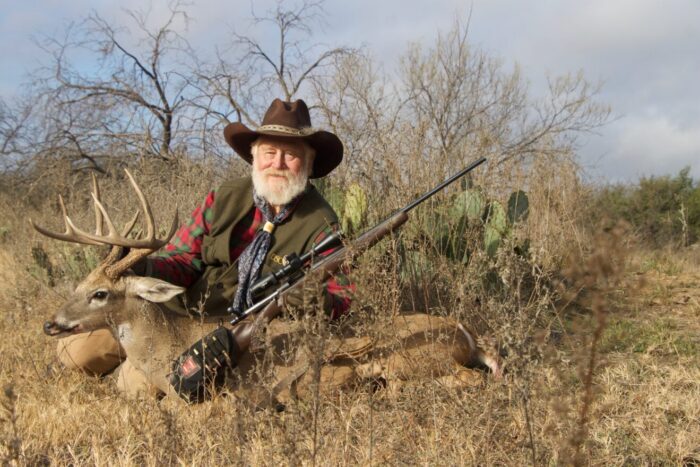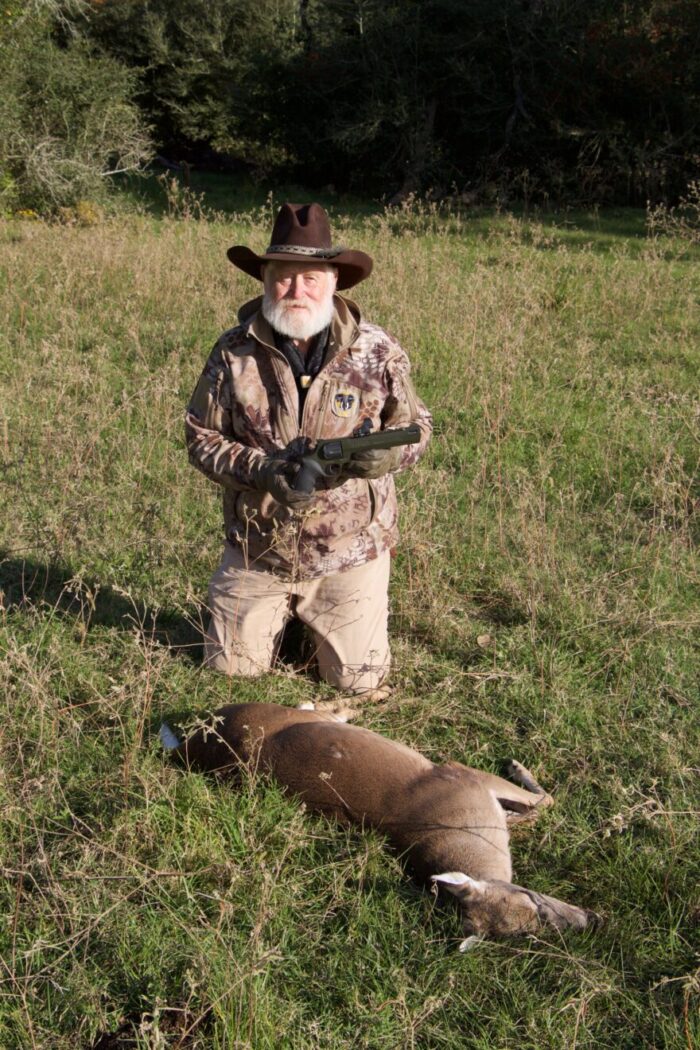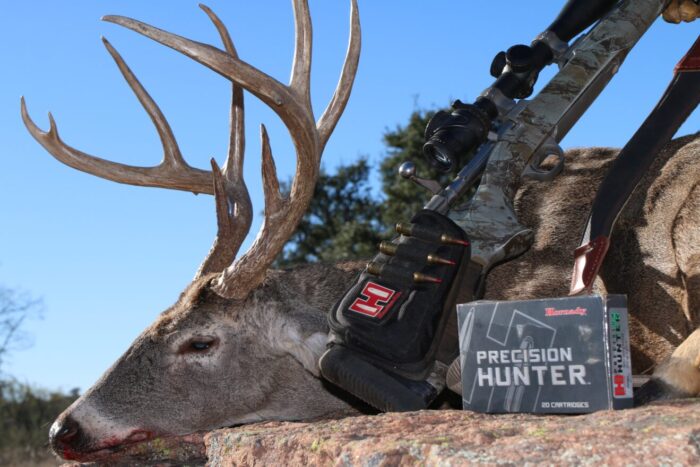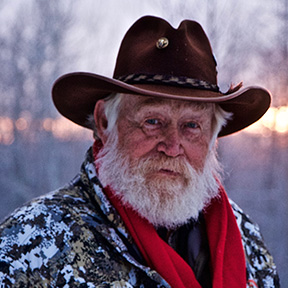Planning the Fall Hunt
“What are you doing this coming weekend?” asked a friend at our 2022 DSC Foundation Gala.
“Going to depend upon whether or not I get the bid on a particular hunt I’m interested here in the auction.” I replied being a bit coy about what hunt I planned to bid on, even though I would be on the stage with fellow DSC Foundation board member, Dave Fulson, introducing and explaining the auction items.
“Hmmm…” he replied, then continued, “Hope you and I won’t be bidding on the same hunt…” I smiled. “Would you mind if I came down to your rifle range and sighted in a new rifle and scope I just bought? It’s a used .300 Win Mag, Remington Model 700. I’m going to replace the scope that came on it with a Trijicon AccuPoint 2.5-12×42. You’ve got them on a couple of your rifles as I recall.”
“Yes Sir, my favorite for all-around hunting. I’ve used them in North America as well as in Europe and even Africa while hunting dangerous game. The 2.5x magnification works well at close range, whether I’m rattling whitetails in Texas or hunting buffalo in Africa. And, I can crank it up to the higher magnification when I need to shoot longer ranges. Excellent choice!”
Then added, “Good way to start preparing for the fall hunting season!”
Unfortunately for me, I did not get the bid. The hunt I wanted went for considerably more than I could afford to spend. And, that was good for our DSC Foundation. All the monies raised that evening will go to support DSC’s missions of Conservation, Education, and Advocacy.
A week later, I met my friend at my range. I handed him a box of Hornady 200-grain ELD-X Precision Hunter ammo. “Try these… I think your rifle will like ‘em. My .300 Win Mag will shoot sub-minute groups using this ammo and I dearly love the terminal performance!”
It took two shots to put my friend’s rifle dead-on at 100-yards. Then after letting the barrel cool he shot a 3-shot group, a tight cloverleaf that could be covered by a nickel.
“Shoot it at 300-yards, which is about the maximum range you’ll likely shoot where you’ll be hunting. Want you to shoot three shots from the bench…then after the barrel cools, set up shooting sticks like you would be doing in the field, then shoot another 3-shot group no different than if you were hunting.” He did. At the bench, from a rock-solid rest, he put three shots easily within a 1 ½-inch group. Shooting from a sitting position using tripod shooting sticks, he put the next three shots into a 3-inch group. It seemed to me at that point he was ready. He had learned the capabilities of his rifle/scope/ammo and his abilities with that combination!
I had earlier done some shooting. This fall, I hope to spend a fair amount of time hunting with my .44 Mag and .454 Casull Taurus Raging Hunter revolvers. The .44 Mag is topped with Trijicon’s SRO, and the .454 Casull wears an RMR (red-dot sight) shooting 240-grain Hornady XTP and 300-grain Hornady XTP respectively. Shooting from the bench, I shot 2-inch 6-shot groups at 100 yards. Shooting from a tripod shooting sticks rest, I consistently put six shots into a 4-inch circle at 100-yards, easily within the vitals of a whitetail deer. That is about the maximum range; I intended to shoot a whitetail with those combinations.
Rifle? I intend to do most of my fall hunting with a .280 Remington using Hornady Precision Hunter, 150-grain ELD-X. That rifle is topped with a Trijicon 2.5-12×42 AccuPoint. Although I do plan on also using my .275 Rigby, .257 Roberts, .280 Ackley Improved, and .300 H&H Mag Ruger No. 1s and possibly a Rossi .45 Colt lever action to shoot some does and hogs. All are topped with Trijicon scopes, AccuPoint, or Huron, and all shooting an appropriate Hornady commercial load.
This fall, I have hunts set up for whitetails in Alberta, Oklahoma, and several Texas hunts and mule deer in Baja and Texas. In Texas this year, I have joined a lease on a large ranch in western Texas under a Texas Parks and Wildlife Department’s Managed Land Deer Permit, which allows the taking of several bucks and does, based upon current populations and long terms goals and objectives. Thus, I will take several whitetails there and hunt with several guns.
Guns, optics, and ammo selected and learning their capabilities and mine with them, my next preparation step is ensuring I have proper clothing and shoes for the particular hunts. My trip to Alberta, Canada, I know will be cold, possibly extremely cold. My hunts in Texas, Oklahoma, and Mexico could range in temperatures of 100+ degrees to near 0 degrees.
To prevent being smelled by deer regardless of where I hunt, I stray my clothing, boots, brown felt hat, leather gloves, and all gear with TRHP Outdoor’s Scent Guardian (www.trhpoutdoors.com). Once I do, I’ll store them in large plastic bags. When I arrive on the hunt, I will again spray all my hunting items as well as myself. Properly sprayed down, I become invisible to the deer’s nose. I have never used a scent control product that works as well as Scent Guardian.
Guns, ammo, optics, clothes, and gear selected for the fall hunts, actually even before doing so, I start walking to get in better physical condition. This is mostly a year-round thing. But, as I get into June, I try to walk a minimum of two miles either morning or night, depending upon the heat (it gets really hot where I live), but I also start carrying a backpack. I start carrying a pack weighing 20-pounds. As the summer progresses, I slowly increase that carried weight to a maximum of 50-pounds. Over the years, I have tried numerous different regimens for getting into hunting shape; this works best for me.
I am fortunate to own a small parcel of land which has been in our family since the mid-1800s. It is where I started hunting as a mere tyke, barely out of “short britches.” It is where I have my rifle range and one of the places where my family and I hunt.
Throughout the year, we do what we can to improve the nutrition of the deer which live and travel through the area. Going back to the winter, I select particular oak trees, as well as specific areas that have a lot of green briars and youpon (a local, holly-like evergreen that deer love) to fertilize. With the oaks, I dig a shallow trench at the tree’s dripline (the outermost branches, where the tree’s feeder roots are). I trickle commercial 13-13-13 fertilizer in the trench. Fertilizing oaks helps them not only to produce acorns each year but the acorns that are “sweeter,” meaning they contain less tannic acid. Occasionally, I do the same with persimmon trees, which occur naturally on my property. But I have also spent considerable time and effort planting both oak and persimmon trees there as well. Too, whenever I can find bois-d-arc, aka horse apple or Osage orange, seeds, I plant them. The latter is one of a deer’s favorite browse, wherever they occur. With the green briar or Smilax vines, I spread fertilizer around the base. If the vines grow into trees, I cut the vines about a foot above the ground to encourage new growth where deer can reach them. With the youpon, I select individual bushes at a height where deer can browse the top of them. I, too, often cut taller youpons down to a level where deer can utilize their top growth.
Deer have an innate ability to search out and feed upon plants that are more palatable and have a higher nutrient content. Thus, by fertilizing, I can create “natural” food plots.
If I am hunting in an area with a lot of oaks, during the late summer, I spend time in the field looking to see what particular oak trees are producing acorns. Sometimes I do this from a distance, glassing tree tops for squirrels. If there are squirrels in the area or a particular tree, chances are excellent there are acorns present.
Mentioning oaks and acorns, deer tend to prefer the acorns from white oak as opposed to red oak trees. These are easily distinguished. White oak trees have leaves with rounded lobes. Red oaks have leave with pointed rather than rounded lobes. White oak acorns tend to have less tannic acid in their acorns.
During the summer months, I often brave the heat in our area and cut winding paths through dense thickets. I cut these paths two to three feet wide, and I wind or zig-zag them through thickets. Deer are no different than you and I when it comes to taking the path of least resistance. By establishing these cleared paths through thickets, I can essentially “lead” deer where I want them to go. To “sweeten” these trails, I also often dribble fertilizer on the edges. Fertilizer causes nutritious growth, which deer will come to.
With summer, I start looking for rubs and scrapes from the previous year. I look for rubs that show use not only from last fall but previous falls as well, meaning looking for rubs that the tree is trying to “heal over.” I like rubs that show multiple years’ use. Bucks often return to the same trees to rub their antlers.
Regarding scrapes, I look for scrapes from the past year. Like rubs, bucks often return to use the same scrape year after year, and often several bucks will use the same scrape. On one of the properties I managed for thirteen years, there were several scrapes that were active every year.
Starting in late July, I start establishing mock scrapes using scents produced by Texas Raised Hunting Products, essentially available through the www.trhpoutdoors.com website, where also can be found instructional videos about making mock scrapes. Setting up these mock scrapes and using TRHP Outdoors’ Pre Orbital scent on vegetation where you intend to hunt during the fall tends not only to draw bucks to an area but hold them there as well.
If you are into using trail cameras, these are great places to set up cameras to get an idea of what is in the area. Me? I no longer use trail cameras. I love being surprised as to what bucks are in the area, or that may pass through. To each his own!
This year, in addition to whitetail hunts I’m doing in Oklahoma on the Choctaw Hunting Lodge (www.choctawhuntinglodge.com), hunting in Alberta with my old friend Ron Nemetcheck, my property, property managed by H3 Whitetail Solutions (www.h3whitetailsolutions.com) I am also hunting a new lease in western Texas. As this is being written, I have not yet visited the lease to do any scouting. Thus, for the time being, my scouting has been from afar. I am currently looking at the ranch from above through Google Earth. I will visit the property for the first time in late July. Based on what I know, the southern portion is relatively flat, while the northern half is rough and rocky with deep canyons. There are some existing, established stands, and there are also large areas that are remote and are seldom hunted. Because the ranch is under a TPWD Managed Land Deer Permit, we can hunt starting the first of October through January and possibly February. That will allow me to spend time on the ranch during the various stages of the rut, from early pre-rut right on through post-rut. I plan on spending time visiting with those who have hunted the property in the past to determine when the best time is to try to rattle in bucks, which I dearly love. A friend who helped me get on the lease tells me bucks in the area respond exceptionally well to rattling.
Spending a couple of days on the lease in July and or August and asking questions of those who have been on the lease for the past several years, I will have an opportunity to learn much about the property.
My intentions regarding this fall’s hunting season are to record as many of my hunts as possible on video to be used on our weekly “A Sportsman’s Life” tv show on www.carbontv.com, but also in my nearly weekly blogs available on www.h3whitetailsolutions.com, www.biggame.org and elsewhere plus my weekly podcasts “DSC’s Campfires with Larry Weishuhn” available at www.carbontv.com and just about anywhere podcasts can be listened to, and, “Campfires with Luke and Larry” primarily available on Sporting Classics Daily’s site and also just about anywhere else.
The summer is upon us, and now is the time to prepare for the coming fall hunts. What are you doing to prepare for a successful and fun-filled fall hunting season?
Professional wildlife biologist/outdoor communicator, Larry Weishuhn, known to many as “Mr. Whitetail”, has established quality wildlife management programs on over 12,000,000 acres throughout North American and other parts of the world. He has hunted big game with rifle and/or handgun on six continents. Larry is a Professional Member of the Boone & Crockett Club, life-member of numerous wildlife conservation organizations including the Dallas Safari Club, Mule Deer Foundation, and Wild Sheep Foundation. He currently serves on the DSC Foundation Board of Directors, is one of three co-founders of the Texas Wildlife Association; is a member of the Legends of the Outdoors Hall of Fame and the Muy Grande Hall of Fame; he too, received the Zeiss Lifetime Achievement Award among many other honors.





